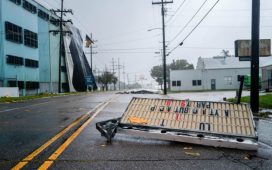Unlock the Editor’s Digest for free
Roula Khalaf, Editor of the FT, selects her favourite stories in this weekly newsletter.
The question of whether climate change is making the world increasingly uninsurable has understandably focused on the places that are currently insured. In areas of the US, Australia and other developed markets, factors including global warming, inflation and building in vulnerable areas have forced prices higher and more people into state-backed schemes.
But there is another urgent problem: the battle to manage climate risks in emerging and developing countries, where levels of insurance cover are much lower. A summit held earlier this month in London by the World Bank and UN-backed Insurance Development Forum, a partnership of insurers and international bodies, sought to bring more attention to these countries, often the ones already dealing with the worst of climate extremes.
The key issue is the so-called protection gap — the level of economic losses in any area not covered by insurance. Last year, insurers covered 31 per cent of economic losses from natural disasters globally, not far off the historic average, according to insurance broker Aon.
But it is unequally spread. In the US, most losses were covered, as is typical, despite a particularly bad year for severe thunderstorms. But the majority of losses in some other regions were uninsured after events such as the devastating earthquakes in Turkey and Syria, and floods in Italy and Greece.
Across Africa, just 7 per cent of natural-disaster losses were covered by insurance, according to Aon’s figures. Some percentages for the lowest-income countries are even smaller, according to other studies.
There is a growing patchwork of publicly backed schemes to help developing countries face up to environmental threats, either through steps to improve their resilience or to share their risks. The Insurance Development Forum is creating a fund for building “resilient and sustainable infrastructure” to help developing and emerging countries deal with climate effects.
There are also public-private schemes known as “microinsurance” aiming to indemnify individual people and communities against some climate-related losses. At the national level, there are programmes to pool the risk of big catastrophes such as hurricanes between different countries.
How to view these in the round? The Insurance Development Forum’s leaders, including its secretary-general Ekhosuehi Iyahen and its chair Michel Liès, also chair at insurance group Zurich, argue that there is increasing need for “country risk officers” in nations that can manage overall risks, including building insurance schemes.
“Having somebody knowing the risk, and balancing the risk and the money, would be so fantastic,” says Liès.
Similar steps have already been taken on extreme weather perils. Several global cities such as Athens already have chief heat officers driving efforts to reduce the risks from heatwaves and fires, as well as building up public awareness.
A broader role, says Iyahen, could create accountability on how countries are dealing with climate risks as well as pandemics and other nationwide threats: “I’m not saying that having a country risk officer will solve the [climate] problem, but it at least is a first step.”
Any move that requires some level of state risk-sharing or spending is likely to be ultimately subject to the same budgetary considerations, so it is hard to see any new job as a shortcut to action on climate. And governments already have actuaries and risk experts employed to take a long-term view.
But as the global insurance industry — for underwriting and socially minded reasons — is working ever harder to reduce the economic impact from extreme weather and putting more weight on resilience, the idea of a country risk head seems timely. The early experience with heat officers suggests they encourage proactive actions to reduce ill-effects.
It might also help in building risk-sharing programmes with external insurers. What gets measured gets managed. And in the insurance sector, if a risk is measured and managed, it is usually easier to find insurance for it.









